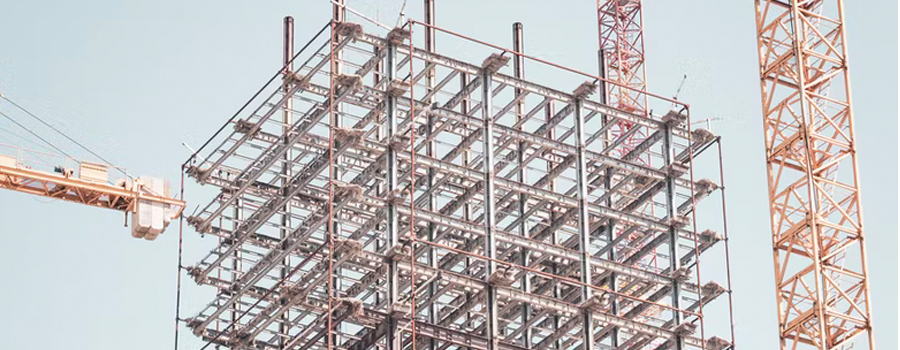
engineering quality control refers to the systematic management activities carried out by using a complete set of quality management systems, means and methods to ensure and improve the quality of the project.many countries in the world have a set of strict supervision and inspection methods for the requirements of engineering quality.project quality control not only provides important data support for the safe construction of the project, but also to be one of the important detection and tracking methods in the maintenance and use phase after the completion of the project, or when there are suspicious problems in the building.
in the context of rapid socio-economic development, various industries are rising rapidly, especially in the field of construction engineering, which has achieved very good development results. the proportion of the industry economy in the socio-economic economy continues to increase, and the number of engineering projects has also increased significantly.for construction projects, quality is the most important construction index. this production index is related to the image and reputation of the enterprise, and it also has a direct impact on the user's living comfort and building safety.for construction enterprises, quality control is a task that enterprises must focus on completing. quality control is an area where problems are not allowed. it needs to attract the attention of enterprises and carry out engineering quality control through various methods.
noa industrial services division has more than 100 professional engineers, inspectors and auditors who are proficient in the manufacture and installation inspection of civil engineering, commercial concrete, boiler and pressure vessels, pipes, valves, steel structures, modules and their mechanical and electrical equipment. all over the country, we provide professional engineering quality control services for enterprises in different fields.
the engineering quality control services provided by noa include but are not limited to:
1、 engineering structure entity detection
2、 project quality assessment
3、 construction safety inspection and assessment
4、 inspection of construction nodes
5、 indoor air quality testing

concrete is an indispensable material in modern construction projects. the quality of concrete structures is related to the overall quality of buildings and has a direct impact on building safety and durability. strengthening the detection of concrete structural entities is crucial to enhancing the quality of structural entities. it is necessary to clarify the testing items and specific testing principles and methods, and select reasonable methods for testing different items.
the content of engineering structure entity detection includes:
1. rebound method to detect the compressive strength of concrete
concrete rebound is the main non-breakage detection method for measuring the compressive strength of concrete. the measured strength of concrete is the key factor and key parameter for evaluating the performance of concrete structures and components.through the rebound detection of a certain number of building floors in the standard section, the overall structural entity of the project can be reflected.concrete rebound detection is widely used because of its simple operation, easy to master, and fast evaluation.at the same time, under the combination of special strength measurement curves, the results of engineering testing are more accurate and the testing is more representative.
2. testing the compressive strength of concrete by core drilling method
the core drilling method uses a core drilling machine to drill core samples on concrete components, and after processing, the compressive strength is tested on a laboratory press. it is a test method for directly obtaining the compressive strength of concrete. the core drilling method can correctly determine the strength of concrete structures.another great advantage of the core drilling method is that the internal conditions of each part of the concrete can be directly observed from the core sample, such as the distribution of aggregates, the length of cracks, etc.
3. component scanning
component scans include inspection of rebar cover thickness and rebar spacing. the detection range is mainly for the components and parts where the location of the reinforcement may significantly affect the bearing capacity and durability of the structural components, such as the longitudinal stress reinforcement of beams and plate members. member scans reflect structural solid performance from the perspective of reinforcement conditions in concrete structures. reinforcement cover thickness and rebar spacing also affect the performance of concrete structures and components. component scanning inspection can help to evaluate the load-bearing capacity and durability of reinforced concrete components. in order to find problems, timely remediation.
4. component size deviation
the detection of component size deviations is mainly to reflect whether the size of the main structural components meet the design requirements, so as to find out whether the size deviations that affect the structural performance and use performance are affected.
5. pull out test of anchor after concrete
concrete rear anchors refer to the use of mechanical anchors, chemical anchors and reinforcement technology to anchor existing concrete structures.the tensile test of concrete rear anchors is a field test to test the anchoring bearing capacity performance of these rear anchors. its purpose is to test whether the axial tensile bearing capacity of the rear anchors meets the requirements of the design bearing capacity through the test. it is suitable for the bearing capacity testing of reinforcement, expansion bolts, and reaming bolts.
6. on-site pull-out test of exterior wall tiles
7. on-site pull-out test of bond strength between insulation board and base
the on-site pull-out test of the bonding strength of the insulation board and the base layer is to use the bonding strength detector to carry out the pull-out test of the external wall insulation system that has been laid to detect the bonding strength between the insulation board and the base layer on the project site. in order to avoid the quality risk caused by unqualified bonding strength.
the full name of project quality assessment is third-party project quality and risk assessment, also known as construction engineering consulting assessment. starting from the first line of the project, through on-site comprehensive inspection, actual measurement, data collection, and systematic analysis of different stages of the project, the management level, quality pass rate, and risk status of the different stages of the project are assessed, and suggestions for improvement are made in a targeted manner, so that the decision makers of the customer unit can clearly grasp the overall quality status of each project under construction, and assist the project manager to clarify the direction of improvement and improve the quality of the project.
project quality assessment includes:
1. actual measurement
the actual measurement refers to a method that can truly reflect the product quality data obtained by using measuring instruments and tools to test the dimensions (including length, width, height) and measurement of the indoor space of the building. the actual measurement mainly involves the main structure stage, masonry stage, plastering stage and fine decoration stage of project development. the scope of measurement covers concrete structure engineering, masonry engineering, equipment installation engineering, plastering engineering, fine decoration engineering and other processes.
2. quality risk assessment
as one of the important components of third-party engineering quality assessment, quality risk assessment can more objectively and effectively reflect the hidden quality problems at the project site. quality risk assessment acts on each stage of the construction project, including: (prevention) leakage, hollow cracking, visual quality, structural safety, management behavior (data inspection) of each participating party in the project, etc.
3. safety and civilization assessment
civilized construction assessment work refers to the inspection of the construction site to discover various defects existing in the safe and civilized construction stage of the project, especially the serious defects that affect the safety of on-site construction. its inspection contents include: electricity and water use, foundation pit engineering, fire protection management, mechanical facilities, large-scale machinery and equipment, scaffolding, unloading platforms, site clearance, material stacking, site gates, construction passages, site enclosures, roads hardening, signage, garbage removal.
factors such as the fluidity of construction and production, the complexity of the production process, and the variability of the working environment can easily lead to safety accidents on the construction site. frequent accidents on the construction and inspection and maintenance sites will not only cause huge economic losses, but also lead to many personal casualties, which bring great risks to the operation of enterprises.through pre-consultation services and on-site inspections, the management and risks in the construction process are reviewed and evaluated in multiple dimensions, suggestions for improvement are put forward, and the direction of improvement is clarified to fully ensure the true and effective implementation of construction safety.
construction safety inspection and assessment includes:
1. civilized construction
safe and civilized construction means that the construction project scientifically organizes safe production during the construction process, normalizes and standardizes the management of the site, so that the construction site maintains a good construction environment and construction order in accordance with the requirements of modern construction. this is a basic management work of construction enterprises.
noa will inspect and assess the civilized construction situation from many aspects such as on-site containment, closure management, construction site, material management, channel protection, and vertical transportation.
2. foundation pit project
the foundation pit project is a highly comprehensive project. the inspection of project nodes can play an important role in project quality management. it can truly reflect the current level of project construction and identify and improve defects in quality management to improve the management level of project construction.
noa will inspect and assess the condition of the foundation pit project from many aspects such as construction plan, foundation pit support, drainage, foundation pit excavation, pit side load, safety protection, foundation pit inspection, support disassembly and assembly, operating environment, and emergency plan.
3. construction electricity
the electricity consumption on the construction site is temporary, open-air, mobile and non-selective compared with the general industrial or residential electricity consumption, and there are different specifications from the general industrial electricity consumption or residential electricity consumption.
noa will inspect and assess the construction electricity consumption from many aspects such as external power protection, grounding and zero-connection protection systems, distribution lines, distribution boxes and switch boxes, distribution rooms and distribution devices, on-site lighting, and electricity consumption files.
4. construction machinery tools
mechanical tools are an inspection part that deserves attention in the construction of construction projects.there are many varieties and quantities of construction equipment, and often irregular conditions can easily cause construction safety accidents and cause personnel and economic losses.
noa will inspect and assess the construction equipment from many aspects such as planing, circular saws, handheld power tools, rebar machinery, electric welding machines, mixers, gas cylinders, dump trucks, submersible pumps, vibrators, piling machinery, and piling machinery.
5. working at a height
working at a height refers to any operation carried out at a height above 2m (including 2m) of the falling height datum where it is possible to fall.ll.when high-altitude operations require carrying, the building or support place should bear the load of the hanging basket. in theory, working at a height has certain risks.
noa will inspect and assess working at a height from many aspects such as safety helmets, safety nets, safety belts, border protection, hole protection, channel protection, climbing operations, floating operations, mobile operating platforms, cantilevered material steel platforms, and unloading platforms.
6. tower crane
in the fields of transportation, construction, etc., tower cranes have also brought new safety risks when they give full play to the high-efficiency advantages that traditional human handling cannot match.therefore, special attention needs to be paid to its safety and stability, so as to avoid large-scale accidents caused by tower cranes.
noa will inspect and assess the lifting situation of the tower crane from many aspects such as load limiting devices, stroke limiting devices, protection devices, hoisting wheels, pulleys, reels and wire ropes, multi-tower operations, tower crane installation, acceptance and use, attachment devices, foundations and tracks, structural facilities, and electrical connections.
7. template bracket
the reliability of the formwork support system is an important part of ensuring the quality and safety of building construction.however, during the construction process, due to technical and management errors, the stability of the template support system will be seriously affected. therefore, it is necessary to raise awareness of the importance of the safety of templates and scaffolding, so as to avoid large-scale accidents.
noa will inspect and assess the template bracket from many aspects such as construction plan, bracket foundation, bracket structure, bracket stability, construction load, submission and acceptance, rod connection, base and support, structure fitting material, and bracket removal.
8. scaffolding, cantilevered scaffolding, attached scaffolding
generally used in concrete construction, bricklaying or decoration, and installation of equipment, it is a very important working platform. because it is cantilevered in the air, there is a greater risk of accidents, so the inspection and assessment of scaffolding is particularly important.
noa will inspect and assess the scaffolding from many aspects such as construction plan, cantilevered steel beam, frame stability, scaffolding, load, delivery and acceptance, rod spacing, frame protection, inter-layer protection, and structural accessories.
9. lifting and hoisting
lifting and hoisting is a large-scale lifting equipment used in the project site. there are many sources of danger and considerable hazards in lifting operations. therefore, special attention needs to be paid to its safety and stability to avoid accidents caused by lifting and hoisting accidents.
noa will inspect and assess the lifting and hoisting situation from many aspects such as construction plan, lifting machinery, wire rope and ground anchor, rigging, operating environment, operators, lifting and hoisting, work at heights, component code placement, alert monitoring, etc.
the inspection of project nodes can play a substantial role in promoting project quality management, truly speaking with data, dynamically and truthfully reflecting the current construction level of the project, systematically discovering and improving weak links in quality management, and promoting the improvement of the level of project construction management.in addition, the inspection of construction nodes can also be combined with material sampling and engineering quality inspection to form a complete quality supervision.
inspection of construction nodes includes:
1. foundation pit safety inspection
foundation pit safety inspection for the inspection of engineering nodes can play an important role in project quality management, can truly reflect the current level of project construction, identify and improve defects in quality management, in order to improve the management level of project construction.
the foundation pit safety inspection services provided by noa involve: whether to prepare a special construction plan; whether there is an emergency plan; whether the foundation pit is constructed according to the drawings; whether the foundation pit is monitored by a qualified third-party monitoring unit; whether the monitoring data is normal; whether there are risk points.
2. form work engineering
the quality of formwork production and installation plays an important role in ensuring the flat appearance and accurate geometry of concrete structures and components, as well as structural strength and stiffness.
the template engineering inspection provided by noa involves: whether the foundation of the bracket is solid and flat; whether the bottom of the bracket is provided with a backing plate or whether the backing plate meets the requirements; whether the sweeping rod is provided; whether the construction load exceeds the design requirements; whether the rod is severely deformed or corroded; whether vertical and horizontal scissor support or special oblique rods are provided; whether the vertical and horizontal spacing of the vertical and horizontal rods and the step distance of the horizontal rods meet the requirements of the specification; whether the high-support mold scheme has been demonstrated by experts.
3.concrete engineering
concrete engineering includes batching, mixing, transportation, pouring, maintenance and other processes.in the entire process, the various processes are closely related and affect each other. if any of the processes is improperly handled, it will affect the final quality of the concrete project.
the concrete engineering inspection provided by noa involves: whether the site is made of concrete test blocks under the same conditions; whether there is a special construction plan for large-volume concrete; whether the poured concrete cleans the joints; the appearance and quality of the formed concrete; and whether cracks appear at the construction joints.
4. reinforcement engineering
the production and lashing quality of reinforcement bar determine the key to the quality of the building structure.
the reinforcement engineering inspection provided by noa involves: the connection method of reinforcement bar; the treatment of reinforcement bar joints and welding; the arrangement of reinforcement bar; the distribution of reinforcement bar; the protective layer; the anchoring length; the positioning of the wall column reinforcement bar; the setting and encryption of stirrups.
5. masonry engineering
masonry engineering refers to the use of ordinary clay bricks, load-bearing clay hollow bricks, autoclaved ash sand bricks, fly ash bricks, various small and medium-sized blocks and stone and other materials for masonry projects in construction projects, including bricklaying, stone, blocks and lightweight wall panels content.
the masonry engineering inspection provided by noa involves: whether the tensile ribs meet the requirements of the specification; whether there is a mesh lap at the interface junction; whether the gray seam is full; whether the ultra-long wall is equipped with structural columns; whether the construction of strong top bricks meets the requirements of the specification; whether the overall flatness meets the requirements.
6. roofing engineering
roofing engineering is an important part of construction work, which is not only related to the overall effect of building construction, but also has a direct and far-reaching impact on building performance.
the roofing engineering inspection provided by noa involves: whether the tensile ribs meet the requirements of the specification; whether there is a mesh lap at the interface junction; whether the gray seam is full; whether the ultra-long wall is equipped with structural columns; whether the construction of strong roof tiles meets the requirements of the specification; whether the overall flatness meets the requirements.
7. waterproof and leak-proof
building waterproofing occupies an important position in the entire construction project. building waterproofing projects involve the basement, wall ground, walls, roofs and many other parts of the building. its function is to prevent rainwater and leakage of production and domestic water and groundwater erosion within the design and durability of the building, so as to ensure that the building structure and internal space are not damaged.
the waterproof and leak-proof inspections provided by noa involve: basement waterproof construction; roof waterproof construction; doors and windows waterproof; kitchen balcony waterproof construction; and the treatment of construction joints.
8. plastering engineering
plastering engineering refers to the systematic construction process of applying plastering mortar to the surface of the base material, which has the effect of protecting the base layer and increasing aesthetics, and providing special functions for the building.
the plastering engineering inspection provided by noa involves: the quality of the construction of the plastering base layer; the inspection of the material, mortar ratio, and ash cake setting before plastering; the low ash inspection, including the thickness, strength, and grid joints of the plastering layer; the yin-yang angle, wall verticality, flatness and other visual quality inspections after the plastering is completed.
9. door and window engineering
the door and window project is a sub-project of a building. the door and window project includes doors and windows. the inspection batches included are: wooden door and window production, wooden door and window installation; steel door and window installation, aluminum alloy (aluminum-plastic) door and window installation, special door installation, door and window glass installation.
the door and window engineering inspection provided by noa involves: whether the anchoring practice is in compliance; whether the waterproof construction of the exterior wall meets the requirements of the specification; whether the aluminum alloy door and window frame is flexibly connected to the hole wall; whether the energy-saving performance test of the three-sex test of doors and windows meets the requirements of the specification.
10. ground engineering (ceramic tiles)
as the surface layer of the terrace or floor, the ground must first play a protective role to make the terrace or floor strong and durable.according to the requirements of different functions, the ground should have the characteristics of wear-resistant, waterproof, non-slip, and easy to clean.
the ground engineering (ceramic tile) inspection provided by noa involves: the technology and perception of ground laying; the technology and perception of ceramic tiles, stones, threshold stones, etc.; whether the ground base treatment meets the requirements of the specification.
11. ground engineering (wooden floor)
as the surface layer of the terrace or floor, the ground must first play a protective role to make the terrace or floor strong and durable.according to the requirements of different functions, the ground should have the characteristics of wear-resistant, waterproof, non-slip, and easy to clean.
the ground engineering (wooden floor) inspection provided by noa involves: the ground laying technology and perception; the wooden floor installation technology and perception; whether the ground base treatment meets the requirements of the specification.
indoor air detection refers to the detection of the composition of the air. mainly from the application point of view, the focus is on indoor air detection. air quality is detected by the pollution caused by the release of substances harmful to the human body contained in interior decoration materials and furniture into furniture and office environments.
indoor air quality inspection includes:
1. tvoc detection
tvoc mainly uses thermal desorbent/capillary gas chromatography for detection.by selecting a suitable adsorbent, a certain volume of air sample is collected with an adsorption tube, and the volatile organic compounds in the air flow are retained in the adsorption tube. after sampling, the adsorption tube is heated to desorb the volatile organic compounds. the sample to be tested enters the capillary meteorological chromatograph with the inert carrier gas, and the retention time is used to characterize, and the peak height or peak area is quantified.
2. formaldehyde detection
formaldehyde-type harmful substances mainly come from decorative materials such as ceilings. wallpaper, paint and some pipes for home decoration are also prone to emit formaldehyde-type substances. ahmt spectrophotometry, phenol reagent spectrophotometry/gas chromatography, and acetylacetone spectrophotometry can be used respectively.
3. toluene and xylene detection
xylene is one of the main pollution sources of indoor air. at present, xylene is often used in indoor decoration instead of pure benzene as a solvent or thinner for various glue paints and waterproof materials. on-site inspection personnel will use activated carbon tubes to collect indoor air, and then send it to the laboratory, and then use gas chromatograph for analysis, with retention time qualitative and peak height quantitative.
4. chlorine and benzene detection
ammonia is one of the main sources of indoor air pollution, mainly from indoor decoration materials, such as additives and whitening agents used in furniture finishing. excessive inhalation of ammonia can cause respiratory diseases.
on-site inspection personnel will use activated carbon tubes to collect indoor air, and then send it to the laboratory to extract the samples to be tested with carbon disulfide. then use a gas chromatograph for analysis, with retention time qualitative and peak height quantitative.
when meeting one of the following conditions, the quality inspection of building structure engineering should be carried out::
(1) the inspection quantity of test blocks, test pieces and related materials related to structural safety is insufficient; (2) the sampling test results of the construction quality do not meet the design requirements; (3) there are doubts or disputes about the construction quality, and the reliability of the structure needs to be further analyzed through testing; (4) in the event of an engineering accident, the cause of the accident and the impact on the reliability of the structure need to be analyzed through testing.
(1) there are many control factors; (2) the control is difficult; (3) the process control requirements are high; (4) the final inspection is limited.
therefore, the construction quality control of engineering projects should emphasize process control, inspection and rectification while construction, and timely inspection records and certification records.





tel: 86-400 821 5138
fax: 86-21 3327 5843
email:noa@noagroup.com